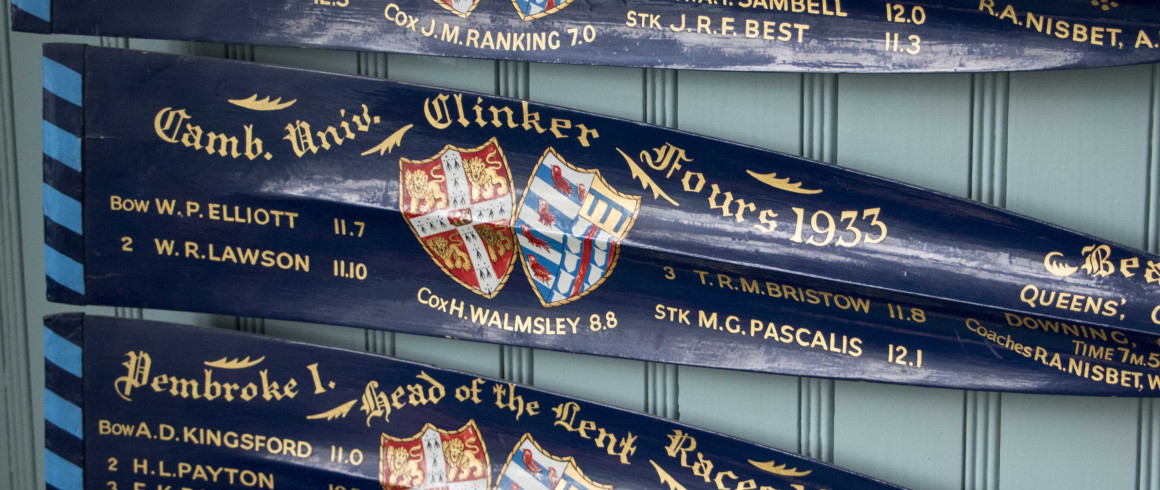A Short History of Bumps, Part 1
Bumps, to the uninitiated, and probably most of the initiated as well, is a strange practice that happens twice a year for a reason no one really remembers. Here we attempt to provide a short history of the races.
[caption id="attachment_28853" align="alignleft" width="200"] A selection of Pembroke blades from Bumps and other races[/caption]
A selection of Pembroke blades from Bumps and other races[/caption]
The Cam is not a river that one would immediately consider ideal for racing. It is winding and so narrow that ‘normal’ races with two boats side by side are not possible. So someone – who was presumably very taken with early versions of dodgems – decided that, instead, boats would line up along the river and attempt to ‘bump’ one another instead.
The first race was in 1827, started by a boatman named Bowtell who had a wooden leg. The starting procedure Bowtell used, of firing a gun – the starting cannon – on three occasions is essentially still the same; only the intervals between each firing are different now. Spectators hear the gun four minutes before starting, 1 minute before starting, and a third time when the race begins. The May bumps separated from the Lent bumps in 1887.
The actual bumping can be a physical hit (often to the consternation of the College Boatman, who is in charge of fixing the results of any particularly enthusiastic bumps) or the crew in front can concede before contact is made. The boats in question then have to immediately get out of the way of following crews, which can be chaotic in situations where the race is quite tight. One of the Pembroke crews managed to entangle itself dramatically with a Downing boat in Lents this year.
[caption id="attachment_28854" align="alignright" width="300"] Photos of Pembroke Women in the Boathouse[/caption]
Photos of Pembroke Women in the Boathouse[/caption]
Starting positions are defined by the finishing order of the previous year, and then by whatever happens during subsequent days' races. Top boats can achieve ‘Head of the River’ if they manage to stay at the top of the first division throughout the four days of racing, and lower boats can achieve ‘blades’ if they bump up every day. The term ‘blades’ comes from early bumps races where each Head crew were given blades, with the cox receiving a rudder. Competitors who don’t do quite so well have the dubious honour of ‘spoons’, reserved for those who are bumped down four times; a much less formal ‘award’.
Women have been part of Bumps only since 1962, when the CUWBC boat raced in the Men’s division; an unfair set-up that resulted in it being bumped within 25 strokes. CUBC was very much against the presence of women in Bumps, and it wasn’t until the 1970s when women were properly admitted to previously all-male Colleges that a women’s division was devised. They first rowed in eights in the 1990s, so the Bumps we see today is still really in it's youth. The inclusion of more women made it chaotic to have CUBC and CUWBC administrating their races separately, so CUCBC was made in the mid-1990s to integrate the two. While some, like Steve Fairbairn, believed strongly in women’s rowing since as early as the 1930s, we have come a long way from the opinion of one individual in the 1960s that, for women, rowing is an “anatomical impossibility” and “physiologically dangerous”!
If you’d like to support Pembroke at this year's May races, you can find all the details here
Source: "The Bumps: An Account of the Cambridge University Bumping Races" by John Durack, George Gilbert and John Marks
